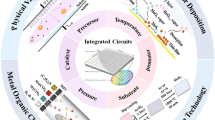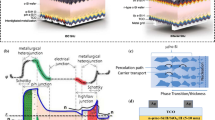Abstract
We report the interface characteristics of Si/Si, Si/SiO2, SiO2/SiO2, Ge/Si, Ge/Ge, and Ge/SiO2 bonded wafers based on an amorphous germanium (a-Ge) intermediate layer. The crystallization of a-Ge and the atom migration mechanism at different bonded structures are very different. The a-Ge turns into polycrystalline Ge (poly-Ge) at Si/Si bonded interface, while it exhibits amorphous phase at Si/SiO2 and SiO2/SiO2 interfaces after post-annealing. This is due to the change of the stress field when SiO2 is introduced. Thanks to the crystallization of a-Ge, serious atom migration appears at Si/Si bonded interface, leading to the decomposition of the interface oxide layer formed by the hydrophilic reaction. Interestingly, the a-Ge at Ge/Si, Ge/Ge, and Ge/SiO2 interface becomes single-crystal Ge after post-annealing. The a-Ge crystallization starts from a-Ge/Ge interface. Similarly, the interface Ge oxide layer also decomposes after the crystallization of a-Ge. This results from the atom redistribution triggered by Ge-induced crystallization under high thermal stress. More importantly, the threading dislocations are not observed at Ge/Si and Ge/SiO2 interface. The Si/Si, Si/SiO2, SiO2/SiO2, and Ge/SiO2 bonded interface is demonstrated to be bubble-free. The transferring of the interface by-products (H2O and H2) by SiO2 and poly-Ge can be responsible for this phenomenon. Finally, a wafer-bonded Ge/Si heterojunction photodiode is fabricated to verify the application of a-Ge wafer bonding technique in photoelectric devices.







Similar content being viewed by others
References
Fukushima T, Iwata E, Konno T, Bea JC, Lee KW, Tanaka T, Koyanagi M (2010) Surface tension-driven chip self-assembly with load-free hydrogen fluoride-assisted direct bonding at room temperature for three-dimensional integrated circuits. Appl Phys Lett 96:154105
Appelbaum I, Huang B, Monsma DJ (2007) Electronic measurement and control of spin transport in silicon. Nature 447:295–298
Brandstetter M, Deutsch C, Krall M, Detz H, MacFarland DC, Zederbauer T, Andrews AM, Schrenk W, Strasser G, Unterrainer K (2013) High power terahertz quantum cascade lasers with symmetric wafer bonded active regions. Appl Phys Lett 103:171113
Liu X, Wu Q, Bai D, Stanley T, Lee A, Su J, Huang B (2017) Temporary wafer bonding materials with mechanical and laser debonding technologies for semiconductor device processing. J Microelectron Electron Packag 14:39–43
Pasquariello D, Hjort K (2002) Plasma-assisted InP-to-Si low temperature wafer bonding. IEEE J Sel Top Quantum Electron 8:118–131
Zhang XX, Raskin JP (2005) Low-temperature wafer bonding: a study of void formation and influence on bonding strength. J Microelectromech Syst 14:368–382
Lin L (2000) MEMS post-packaging by localized heating and bonding. IEEE Trans Adv Packag 23:608–616
Chen L, Dong P, Lipson M (2008) High performance germanium photodetectors integrated on submicron silicon waveguides by low temperature wafer bonding. Opt Express 16:11513–11518
Pan CT, Yang H, Shen SC, Chou MC, Chou HP (2002) A low-temperature wafer bonding technique using patternable materials. J Micromech Microeng 12:611–615
Niklaus F, Enoksson P, Kälvesten E, Stemme G (2001) Low-temperature full wafer adhesive bonding. J Micromech Microeng 11:100–107
Niklaus F, Andersson H, Enoksson P, Stemme G (2001) Low temperature full wafer adhesive bonding of structured wafers. Sens Actuators A 92:235–241
Tong QY, Scholz R, Gösele U, Lee TH, Huang LJ, Chao YL, Tan TY (1998) A “smarter-cut” approach to low temperature silicon layer transfer. Appl Phys Lett 72:49–51
Kibria MG, Zhang F, Lee TH, Kim MJ, Howlader MMR (2010) Comprehensive investigation of sequential plasma activated Si/Si bonded interfaces for nano-integration on the wafer scale. Nanotechnology 21:134011
Ventosa C, Rieutord F, Libralesso L, Morales C, Fournel F, Moriceau H (2008) Hydrophilic low-temperature direct wafer bonding. J Appl Phys 104:123524
Fournel F, Moriceau H, Ventosa C, Libralesso L, Le Tiec Y, Signamarcheix T, Rieutord F (2008) Low temperature wafer bonding. ECS Trans 16:475–488
Gity F, Yeol Byun K, Lee KH, Cherkaoui K, Hayes JM, Morrison AP, Colinge C, Corbett B (2012) Characterization of germanium/silicon p–n junction fabricated by low temperature direct wafer bonding and layer exfoliation. Appl Phys Lett 100:092102
Gity F, Daly A, Snyder B, Peters FH, Hayes J, Colinge C, Morrison AP, Corbett B (2013) Ge/Si heterojunction photodiodes fabricated by low temperature wafer bonding. Opt Express 21:17309–17314
Kanbe H, Miyaji M, Ito T (2008) Ge/Si heterojunction photodiodes fabricated by low temperature wafer bonding. Appl Phys Express 1:072301
Lasky JB (1986) Wafer bonding for silicon-on-insulator technologies. Appl Phys Lett 48:78–80
Bruel M, Aspar B, Auberton-Hervé AJ (1997) Smart-Cut: a new silicon on insulator material technology based on hydrogen implantation and wafer bonding. Jpn J Appl Phys 36:1636–1641
Yu CY, Lee CY, Lin CH, Liu CW (2006) Low-temperature fabrication and characterization of Ge-on-insulator structures. Appl Phys Lett 89:101913
Ferain IP, Byun KY, Colinge CA, Brightup S, Goorsky MS (2010) Low temperature exfoliation process in hydrogen-implanted germanium layers. J Appl Phys 107:054315
Maeda T, Chang WH, Irisawa T, Ishii H, Hattori H, Poborchii V, Kurashima K, Takagi H, Uchida N (2016) Advanced germanium layer transfer for ultra thin body on insulator structure. Appl Phys Lett 109:262104
Toyoda E, Sakai A, Isogai H, Senda T, Izunome K, Nakatsuka O, Ogawa M, Zaima S (2009) Mechanical properties and chemical reactions at the directly bonded Si–Si Interface. Jpn J Appl Phys 48:011202
Wang C, Suga T (2012) Investigation of fluorine containing plasma activation for room-temperature bonding of Si-based materials. Microelectron Reliab 52:347–351
Ventosa C, Rieutord F, Libralesso L, Fournel F, Morales C, Moriceau H (2008) Effect of pre-bonding thermal treatment on the bonding interface evolution in direct Si–Si hydrophilic wafer bonding. ECS Trans 16:361–368
Kanbe H, Komatsu M, Miyaji M (2006) Ge/Si Heterojunction photodiodes fabricated by wafer bonding. Jpn J Appl Phys 45:L644–L646
Kanbe H, Hirose M, Ito T, Taniwaki M (2010) Crystallographic properties of Ge/Si heterojunctions fabricated by wet wafer bonding. J Electron Mater 39:1248–1255
Kanbe H, Miyaji M, Hirose M, Nitta N, Taniwaki M (2007) Analysis of a wafer bonded Ge/Si heterojunction by transmission electron microscopy. Appl Phys Lett 91:142119
Miki N, Zhang X, Khanna R, Ayon AA, Ward D, Spearing SM (2003) Multi-stack silicon-direct wafer bonding for 3D MEMS manufacturing. Sens Actuators, A 103:194–201
Ayon AA, Zhang X, Turner KT, Choi D, Miller B, Nagle SF, Spearing SM (2003) Characterization of silicon wafer bonding for power MEMS applications. Sens Actuators A 103:1–8
Yang HA, Wu M, Fang W (2004) Localized induction heating solder bonding for wafer level MEMS packaging. J Micromech Microeng 15:394–399
Howlader MMR, Suehara S, Takagi H, Kim TH, Maeda R, Suga T (2006) Room-temperature microfluidics packaging using sequential plasma activation process. IEEE Trans Adv Packag 29:448–456
Howlader MMR, Wang JG, Kim MJ (2010) Influence of nitrogen microwave radicals on sequential plasma activated bonding. Mater Lett 64:445–448
Wang C, Liu Y, Suga T (2017) A comparative study: void formation in silicon wafer direct bonding by oxygen plasma activation with and without fluorine. ECS J Solid State Sci Technol 6:P7–P13
Howlader MR, Itoh H, Suga T, Kim M (2006) Sequential plasma activated process for silicon direct bonding. ECS Trans 3:191–202
Byun KY, Fleming P, Bennett N, Gity F, McNally P, Morris M, Ferain I, Colinge C (2011) Comprehensive investigation of Ge–Si bonded interfaces using oxygen radical activation. J Appl Phys 109:123529
Byun KY, Ferain I, Fleming P, Morris M, Goorsky M, Colinge C (2010) Low temperature germanium to silicon direct wafer bonding using free radical exposure. Appl Phys Lett 96:102110
Gity F, Byun KY, Lee K, Cherkaoui K, Hayes JM, Morrison AP, Colinge C, Corbett B (2012) Ge/Si pn diode fabricated by direct wafer bonding and layer exfoliation. ECS Trans 45:131–139
Samavedam SB, Currie MT, Langdo TA, Fitzgerald EA (1998) High-quality germanium photodiodes integrated on silicon substrates using optimized relaxed graded buffers. Appl Phys Lett 73:2125–2127
Malta DP, Posthill JB, Markunas RJ, Humphreys TP (1992) Low-defect-density germanium on silicon obtained by a novel growth phenomenon. Appl Phys Lett 60:844–846
Kobayashi SI, Nishi Y, Saraswat KC (2010) Effect of isochronal hydrogen annealing on surface roughness and threading dislocation density of epitaxial Ge films grown on Si. Thin Solid Films 518:S136–S139
Colace L, Masini G, Assanto G, Luan HC, Wada K, Kimerling LC (2000) Efficient high-speed near-infrared Ge photodetectors integrated on Si substrates. Appl Phys Lett 76:1231–1233
Lee SW, Chen HC, Chen LJ, Peng YH, Kuan CH, Cheng HH (2002) Effects of low-temperature Si buffer layer thickness on the growth of SiGe by molecular beam epitaxy. J Appl Phys 92:6880–6885
de Lima Jr MM, Lacerda RG, Vilcarromero J, Marques FC (1999) Coefficient of thermal expansion and elastic modulus of thin films. J Appl Phys 86:4936–4942
Olmos D, Martínez F, González-Gaitano G, González-Benito J (2011) Effect of the presence of silica nanoparticles in the coefficient of thermal expansion of LDPE. Eur Polym J 47:1495–1502
Plach T, Hingerl K, Tollabimazraehno S, Hesser G, Dragoi V, Wimplinger M (2013) Mechanisms for room temperature direct wafer bonding. J Appl Phys 113:094905
Lee KH, Jandl A, Tan YH, Fitzgerald EA, Tan CS (2013) Growth and characterization of germanium epitaxial film on silicon (001) with germane precursor in metal organic chemical vapour deposition (MOCVD) chamber. AIP Adv 3:092123
Tan YH, Tan CS (2012) Growth and characterization of germanium epitaxial film on silicon (001) using reduced pressure chemical vapor deposition. Thin Solid Films 520:2711–2716
Liu J, Michel J, Giziewicz W, Pan D, Wada K, Cannon DD, Jongthammanurak S, Danielson DT, Ilday FÖ (2005) High-performance, tensile-strained Ge p–i–n photodetectors on a Si platform. Appl Phys Lett 87:103501
Sukhdeo DS, Nam D, Kang JH, Brongersma ML, Saraswat KC (2014) Direct bandgap germanium-on-silicon inferred from 5.7% <100> uniaxial tensile strain. Photonics Res 2:A8–A13
Jain JR, Hryciw A, Baer TM, Miller DA, Brongersma ML, Howe RT (2012) A micromachining-based technology for enhancing germanium light emission via tensile strain. Nat Photonics 6:398–405
Acknowledgements
This work was supported by the National Natural Science Foundation of China (Grant Nos. 61534005 and 61474081), the Natural Science Foundation of Fujian Province (Grant No. 2015D020), the Science and Technology project of Xiamen City (Grant No. 3502Z20154091).
Author information
Authors and Affiliations
Corresponding author
Ethics declarations
Conflict of interest
The authors declare that they have no conflict of interest.
Rights and permissions
About this article
Cite this article
Ke, S., Ye, Y., Wu, J. et al. Interface characteristics of different bonded structures fabricated by low-temperature a-Ge wafer bonding and the application of wafer-bonded Ge/Si photoelectric device. J Mater Sci 54, 2406–2416 (2019). https://doi.org/10.1007/s10853-018-3015-8
Received:
Accepted:
Published:
Issue Date:
DOI: https://doi.org/10.1007/s10853-018-3015-8




